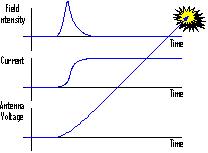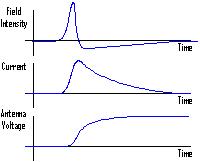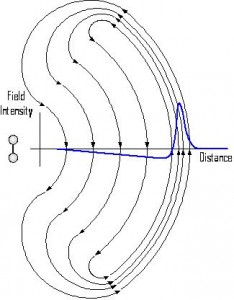Maxwell first published his famous equations describing electricity and magnetic one hundred fifty years ago. In honor of the anniversary, ÆtherCzar will discuss some interesting and not always appreciated aspects of Maxwell’s Equations. Previously, ÆtherCzar considered the question, “Is radiation divergenceless?” Today’s topic: Radiation of a DC Signal?
The last post in this series demonstrated that radiation field lines form closed loops. Understanding that radiation fields have neither source nor sink leads relatively painlessly to another basic principle of UWB systems. The complete time integral of a radiated waveform must be equal to zero. Expressed mathematically,
![]() There must be as much positive excursion of the radiated waveform as there is negative excursion. For every radiation field line pointing in one direction, there must be an equal and opposite radiation field line pointing in the other direction. A corollary to this rule might be stated, “You can’t radiate dc.”
There must be as much positive excursion of the radiated waveform as there is negative excursion. For every radiation field line pointing in one direction, there must be an equal and opposite radiation field line pointing in the other direction. A corollary to this rule might be stated, “You can’t radiate dc.”
Suppose one attempted to excite an antenna so as to create a radiated waveform whose field intensity had a net positive excursion. Such an excitation would require an antenna current that did not return to zero at the end of the radiation. Thus, the antenna voltage would have to continue to grow, a process that could not continue forever. The figure illustrates what radiating a “dc impulse” implies for antenna current and voltage.
 Of course, this “no dc” rule still allows considerable flexibility for designing a UWB system with a radiated impulse that is almost, but not quite, dc. For instance, one might quickly increase antenna current, then allow it to decay gradually. The net positive antenna current flow leaves a net positive antenna voltage in its wake. The Figure below shows how a quasi-dc impulse may be created with a physically realizable antenna current and voltage.
Of course, this “no dc” rule still allows considerable flexibility for designing a UWB system with a radiated impulse that is almost, but not quite, dc. For instance, one might quickly increase antenna current, then allow it to decay gradually. The net positive antenna current flow leaves a net positive antenna voltage in its wake. The Figure below shows how a quasi-dc impulse may be created with a physically realizable antenna current and voltage.
 Note how the total positive field intensity excursion in the quasi-dc impulse is balanced by a long, gradual, negative field intensity precursor. The Figure below provides a qualitative diagram of the radiation field lines that might be associated with a quasi-dc impulse.
Note how the total positive field intensity excursion in the quasi-dc impulse is balanced by a long, gradual, negative field intensity precursor. The Figure below provides a qualitative diagram of the radiation field lines that might be associated with a quasi-dc impulse.
 Note: this blog post contains material originally presented in my book, The Art and Science of Ultrawideband Antennas, (Artech House, 2005) pp. 133-135.
Note: this blog post contains material originally presented in my book, The Art and Science of Ultrawideband Antennas, (Artech House, 2005) pp. 133-135.

